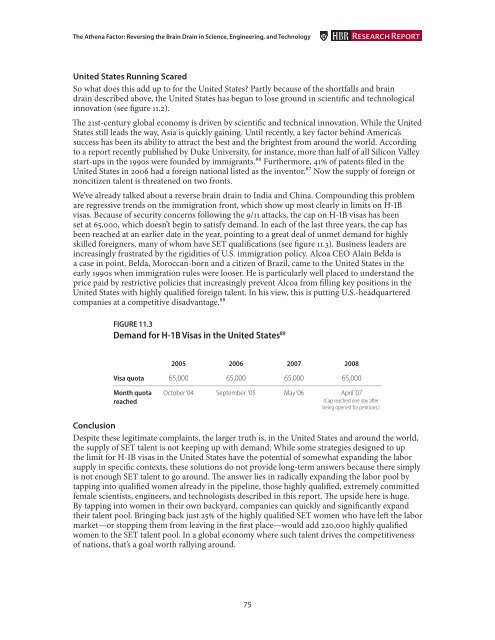HD6060-.A84-2008-PDF-Athena-factor-Reversing-the-brain-drain-in-science,-engineering,-and-technology
HD6060-.A84-2008-PDF-Athena-factor-Reversing-the-brain-drain-in-science,-engineering,-and-technology
HD6060-.A84-2008-PDF-Athena-factor-Reversing-the-brain-drain-in-science,-engineering,-and-technology
Create successful ePaper yourself
Turn your PDF publications into a flip-book with our unique Google optimized e-Paper software.
The <strong>A<strong>the</strong>na</strong> Factor: <strong>Revers<strong>in</strong>g</strong> <strong>the</strong> Bra<strong>in</strong> Dra<strong>in</strong> <strong>in</strong> Science, Eng<strong>in</strong>eer<strong>in</strong>g, <strong>and</strong> Technology<br />
HBR Research Report<br />
United States Runn<strong>in</strong>g Scared<br />
So what does this add up to for <strong>the</strong> United States? Partly because of <strong>the</strong> shortfalls <strong>and</strong> <strong>bra<strong>in</strong></strong><br />
<strong>dra<strong>in</strong></strong> described above, <strong>the</strong> United States has begun to lose ground <strong>in</strong> scientific <strong>and</strong> technological<br />
<strong>in</strong>novation (see figure 11.2).<br />
The 21st-century global economy is driven by scientific <strong>and</strong> technical <strong>in</strong>novation. While <strong>the</strong> United<br />
States still leads <strong>the</strong> way, Asia is quickly ga<strong>in</strong><strong>in</strong>g. Until recently, a key <strong>factor</strong> beh<strong>in</strong>d America’s<br />
success has been its ability to attract <strong>the</strong> best <strong>and</strong> <strong>the</strong> brightest from around <strong>the</strong> world. Accord<strong>in</strong>g<br />
to a report recently published by Duke University, for <strong>in</strong>stance, more than half of all Silicon Valley<br />
start-ups <strong>in</strong> <strong>the</strong> 1990s were founded by immigrants.86 Fur<strong>the</strong>rmore, 41% of patents filed <strong>in</strong> <strong>the</strong><br />
United States <strong>in</strong> 2006 had a foreign national listed as <strong>the</strong> <strong>in</strong>ventor.87 Now <strong>the</strong> supply of foreign or<br />
noncitizen talent is threatened on two fronts.<br />
We’ve already talked about a reverse <strong>bra<strong>in</strong></strong> <strong>dra<strong>in</strong></strong> to India <strong>and</strong> Ch<strong>in</strong>a. Compound<strong>in</strong>g this problem<br />
are regressive trends on <strong>the</strong> immigration front, which show up most clearly <strong>in</strong> limits on H-1B<br />
visas. Because of security concerns follow<strong>in</strong>g <strong>the</strong> 9/11 attacks, <strong>the</strong> cap on H-1B visas has been<br />
set at 65,000, which doesn’t beg<strong>in</strong> to satisfy dem<strong>and</strong>. In each of <strong>the</strong> last three years, <strong>the</strong> cap has<br />
been reached at an earlier date <strong>in</strong> <strong>the</strong> year, po<strong>in</strong>t<strong>in</strong>g to a great deal of unmet dem<strong>and</strong> for highly<br />
skilled foreigners, many of whom have SET qualifications (see figure 11.3). Bus<strong>in</strong>ess leaders are<br />
<strong>in</strong>creas<strong>in</strong>gly frustrated by <strong>the</strong> rigidities of U.S. immigration policy. Alcoa CEO Ala<strong>in</strong> Belda is<br />
a case <strong>in</strong> po<strong>in</strong>t. Belda, Moroccan-born <strong>and</strong> a citizen of Brazil, came to <strong>the</strong> United States <strong>in</strong> <strong>the</strong><br />
early 1990s when immigration rules were looser. He is particularly well placed to underst<strong>and</strong> <strong>the</strong><br />
price paid by restrictive policies that <strong>in</strong>creas<strong>in</strong>gly prevent Alcoa from fill<strong>in</strong>g key positions <strong>in</strong> <strong>the</strong><br />
United States with highly qualified foreign talent. In his view, this is putt<strong>in</strong>g U.S.-headquartered<br />
companies at a competitive disadvantage.88<br />
FIGURE 11.3<br />
Dem<strong>and</strong> for H-1B Visas <strong>in</strong> <strong>the</strong> United States 89<br />
2005<br />
2006<br />
2007<br />
<strong>2008</strong><br />
Visa quota<br />
65,000<br />
65,000<br />
65,000<br />
65,000<br />
Month quota<br />
reached<br />
October ‘04<br />
September ‘05<br />
May ‘06<br />
April ‘07<br />
(Cap reached one day after<br />
be<strong>in</strong>g opened for petitions.)<br />
Conclusion<br />
Despite <strong>the</strong>se legitimate compla<strong>in</strong>ts, <strong>the</strong> larger truth is, <strong>in</strong> <strong>the</strong> United States <strong>and</strong> around <strong>the</strong> world,<br />
<strong>the</strong> supply of SET talent is not keep<strong>in</strong>g up with dem<strong>and</strong>. While some strategies designed to up<br />
<strong>the</strong> limit for H-1B visas <strong>in</strong> <strong>the</strong> United States have <strong>the</strong> potential of somewhat exp<strong>and</strong><strong>in</strong>g <strong>the</strong> labor<br />
supply <strong>in</strong> specific contexts, <strong>the</strong>se solutions do not provide long-term answers because <strong>the</strong>re simply<br />
is not enough SET talent to go around. The answer lies <strong>in</strong> radically exp<strong>and</strong><strong>in</strong>g <strong>the</strong> labor pool by<br />
tapp<strong>in</strong>g <strong>in</strong>to qualified women already <strong>in</strong> <strong>the</strong> pipel<strong>in</strong>e, those highly qualified, extremely committed<br />
female scientists, eng<strong>in</strong>eers, <strong>and</strong> technologists described <strong>in</strong> this report. The upside here is huge.<br />
By tapp<strong>in</strong>g <strong>in</strong>to women <strong>in</strong> <strong>the</strong>ir own backyard, companies can quickly <strong>and</strong> significantly exp<strong>and</strong><br />
<strong>the</strong>ir talent pool. Br<strong>in</strong>g<strong>in</strong>g back just 25% of <strong>the</strong> highly qualified SET women who have left <strong>the</strong> labor<br />
market—or stopp<strong>in</strong>g <strong>the</strong>m from leav<strong>in</strong>g <strong>in</strong> <strong>the</strong> first place—would add 220,000 highly qualified<br />
women to <strong>the</strong> SET talent pool. In a global economy where such talent drives <strong>the</strong> competitiveness<br />
of nations, that’s a goal worth rally<strong>in</strong>g around.<br />
75


